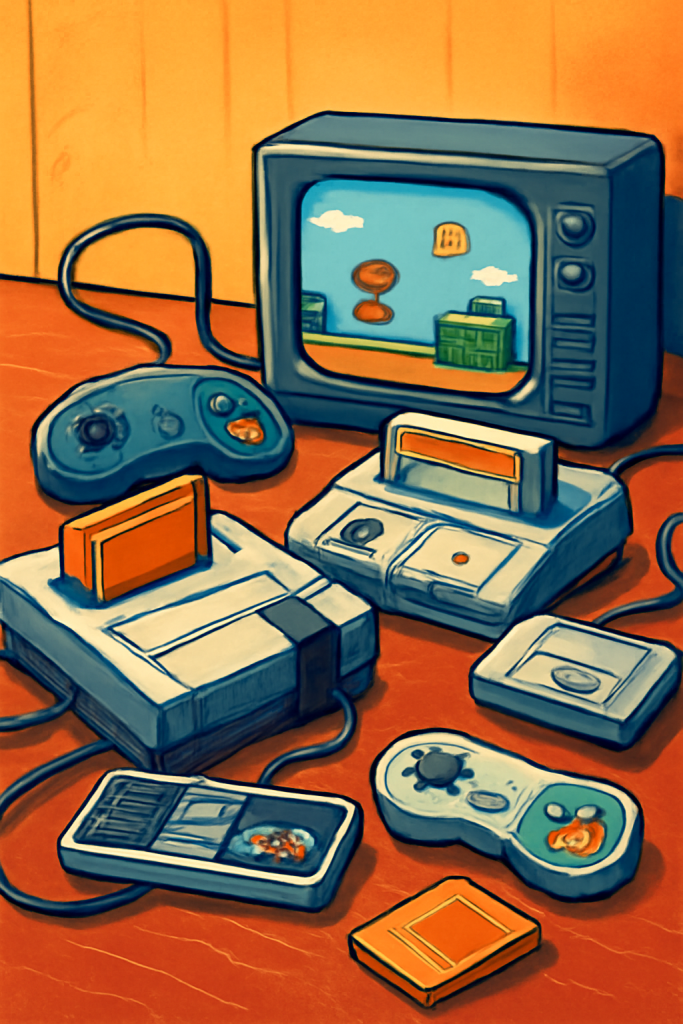Retro gaming, a term referring to the playing of video games from past generations, has experienced a remarkable resurgence in recent years. Once considered a niche interest, retro gaming has become a dominant force in the gaming community. From nostalgic enthusiasts revisiting their childhood favorites to new generations discovering the charm of pixelated graphics and 8-bit soundtracks, there are many factors contributing to the rise of retro gaming. But what’s really behind this growing trend? In this article, we will explore the key drivers behind the retro gaming boom and what it means for the future of the gaming industry.

The Allure of Nostalgia: Why People Love Retro Gaming
One of the primary reasons for the rise of retro gaming is the powerful nostalgia it evokes. For many players, retro games bring back fond memories of their childhood or earlier years. Whether it’s the early days of the NES, the Sega Genesis, or the Super Nintendo, these consoles were part of a time when gaming was simpler and more accessible.
Nostalgia plays a significant role in the revival of old-school games, as it provides an emotional connection to the past. The familiarity of these games, combined with their simpler mechanics and timeless appeal, makes them attractive to both longtime gamers and those new to the world of retro gaming. The charm of pixel art, chiptune music, and the absence of complex narratives or overwhelming graphics allows players to focus on gameplay in its purest form.
Why Nostalgia Drives the Trend:
- Emotional connection: Games from past decades trigger memories of personal experiences, sparking a sense of comfort and joy.
- Simplicity: Retro games are often straightforward and don’t require hours of tutorial time, which appeals to players seeking quick and satisfying gaming sessions.
- Cultural impact: Games like Super Mario Bros., The Legend of Zelda, and Pac-Man were cultural touchstones that influenced many modern gaming franchises, enhancing their staying power.
A New Generation Discovers Retro Games
While nostalgia undoubtedly fuels the rise of retro gaming, the trend isn’t limited to older generations. In fact, one of the most exciting developments in the world of retro gaming is how younger players are getting involved. Millennials and Gen Z, who did not experience these games in their original form, are increasingly flocking to retro gaming for the first time.
Modern technology has made it easier than ever for younger gamers to explore the classics. Platforms like Nintendo Switch, PlayStation, Xbox, and PC offer a wide variety of retro games through digital storefronts, collections, and online services like Nintendo’s Virtual Console and Xbox Game Pass. Emulators and retro consoles like the Sega Genesis Mini and SNES Classic allow fans to play vintage games without the need for original hardware.
This accessibility, combined with a strong online community that celebrates retro gaming, has sparked an interest in games from the past. Younger generations are not just playing these games—they’re developing a deep appreciation for their historical significance, aesthetics, and innovation.
Factors Contributing to Younger Audiences Embracing Retro Games:
- Digital accessibility: Games are now available on modern platforms, making it easy for younger players to discover and experience retro titles.
- Streaming culture: The rise of live-streaming platforms like Twitch has allowed gamers to explore retro games through streaming sessions, attracting new fans.
- Game preservation: Services like PlayStation Plus and Xbox Live allow players to access a catalog of retro games, preserving gaming history for new audiences.
The Impact of Game Preservation and Re-releases
Game preservation plays a vital role in the growing interest in retro gaming. As gaming evolves rapidly, many classic games would otherwise be lost to time. However, developers and publishers have recognized the importance of keeping these games accessible to new generations. Re-releases, remakes, and remasters of older games have become a standard practice, allowing retro games to live on in modern formats.
For instance, The Legend of Zelda: Link’s Awakening received a stunning remake for the Nintendo Switch, capturing the essence of the original while enhancing it with updated graphics and mechanics. Similarly, Final Fantasy VII Remake brought a beloved classic into the modern era while maintaining the spirit of the original. These updated versions not only cater to long-time fans but also introduce iconic games to a new generation of players.
Additionally, digital game libraries, such as Steam, GOG, and the aforementioned services like Nintendo Switch Online, offer access to countless retro games from various platforms. These services make it easy for players to rediscover old favorites or try out titles they missed the first time around.
Key Benefits of Game Preservation:
- Accessibility: Re-releases and remakes make retro games accessible to modern gamers with updated platforms.
- Improved experience: Remasters and remakes often enhance graphics and sound, appealing to modern sensibilities while preserving the original gameplay.
- Cultural legacy: By preserving retro games, developers ensure that future generations can enjoy and learn from the history of gaming.
The Influence of Retro Aesthetics in Modern Gaming
Another driving force behind the retro gaming resurgence is the increasing influence of retro aesthetics in modern titles. Indie game developers, in particular, have embraced pixel art and chiptune music, drawing inspiration from retro gaming’s visual and auditory style. Games like Stardew Valley, Shovel Knight, and Celeste feature pixelated graphics and 8-bit soundtracks that harken back to the golden era of gaming.
This retro-inspired design is appealing for several reasons. For one, it evokes nostalgia in older players, while also offering a fresh, stylized aesthetic for younger gamers who may not have experienced the originals. Furthermore, the simplicity of pixel art allows indie developers to create visually striking games without the need for high-end graphics technology, making retro aesthetics both an artistic choice and a practical one.
The combination of retro visuals and modern gameplay mechanics has led to the rise of a new genre known as “neo-retro,” where classic gaming principles are blended with contemporary innovation. This genre not only celebrates the past but also brings it into the present in a meaningful way.
Examples of Modern Retro-Inspired Games:
- Stardew Valley: A farming simulator with pixel art visuals and gameplay inspired by classics like Harvest Moon.
- Shovel Knight: A platformer that channels the look and feel of 8-bit games, while introducing modern gameplay mechanics.
- Celeste: A challenging platformer with pixel graphics and a chiptune soundtrack, combining old-school difficulty with a heartfelt narrative.
Collecting Retro Games: A Thriving Market
The market for physical retro games has also seen a resurgence. Collecting vintage games and consoles has become a popular hobby, and prices for rare games and limited-edition hardware have skyrocketed in recent years. Auction sites like eBay, retro game shops, and conventions have become hot spots for collectors seeking classic cartridges, console systems, and memorabilia.
This growing interest in retro gaming as a collectible market reflects a broader trend in the gaming world: an appreciation for the history of video games as an art form. For many collectors, owning a piece of gaming history is just as rewarding as playing the games themselves. The limited availability of certain games, combined with their historical significance, has made these collectibles highly sought after.
Factors Driving the Retro Game Collecting Trend:
- Rarity: Vintage games, especially those in good condition, have become rare and valuable collectibles.
- Nostalgia: Collecting games from childhood or previous decades provides a tangible connection to the past.
- Investment: Many collectors view retro games as an investment, as some rare titles have seen significant increases in value over the years.
Conclusion
The rise of retro gaming is a multifaceted trend fueled by nostalgia, accessibility, game preservation, modern interpretations of retro aesthetics, and a thriving collector’s market. While the games of the past continue to provide entertainment, they also play an important role in preserving the cultural history of video gaming. Whether it’s revisiting old favorites or discovering them for the first time, the resurgence of retro gaming is a trend that shows no signs of slowing down.
As the gaming industry continues to evolve, retro games will undoubtedly remain a vital part of the gaming landscape, inspiring both new and old generations of players alike.
References:
- “Why Retro Gaming is on the Rise” – TechRadar
- “The Revival of Retro Games: How Nostalgia is Changing the Gaming Industry” – The Verge
- “Retro Gaming is More Popular Than Ever” – Polygon









